肯定句 否定句 疑问句之变形技巧
英语肯定句改为否定句、陈述句改为一般疑问句的方法和技巧
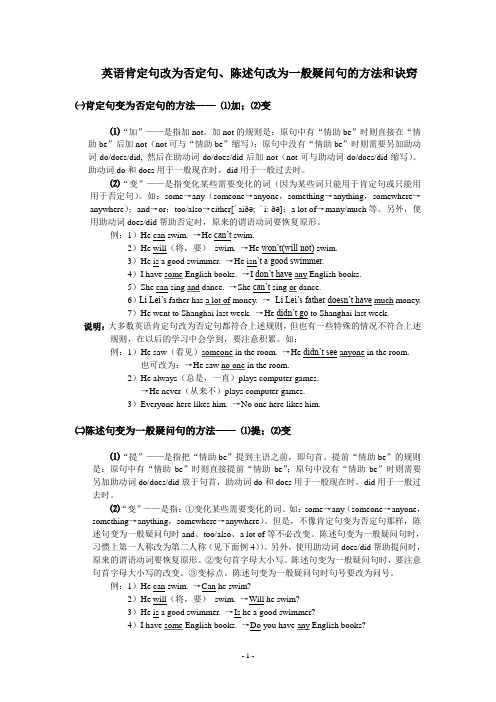
英语肯定句改为否定句、陈述句改为一般疑问句的方法和诀窍㈠肯定句变为否定句的方法——⑴加;⑵变⑴“加”——是指加not。
加not的规则是:原句中有“情助be”时则直接在“情助be”后加not(not可与“情助be”缩写);原句中没有“情助be”时则需要另加助动词do/does/did, 然后在助动词do/does/did后加not(not可与助动词do/does/did缩写)。
助动词do和does用于一般现在时,did用于一般过去时。
⑵“变”——是指变化某些需要变化的词(因为某些词只能用于肯定句或只能用用于否定句)。
如:some→any(someone→anyone,something→anything,somewhere→anywhere);and→or;too/also→either[´aiðə; ´i: ðə];a lot of→many/much等。
另外,使用助动词does/did帮助否定时,原来的谓语动词要恢复原形。
例:1)He can swim. →He can’t swim.2)He will(将,要)swim. →He won’t(will not) swim.3)He is a good swimmer. →He isn’t a good swimmer.4)I have some English books. →I don’t have any English books.5)She can sing and dance. →She can’t sing or dance.6)Li Lei’s father has a lot of money. →Li Lei’s father doesn’t have much money.7)He went to Shanghai last week. →He didn’t go to Shanghai last week.说明:大多数英语肯定句改为否定句都符合上述规则,但也有一些特殊的情况不符合上述规则,在以后的学习中会学到,要注意积累。
小学英语句型转换之肯定句改否定句、一般疑问句

小学英语句型转换之肯定句改否定句、一般疑问句一、肯定句改否定句的方法1.直接在be动词(am, is, are, was, were)后加not。
如:is not ,are not ,am not。
如果有some 就改成any,其余照抄。
2.直接在can,should,will等后加not。
如:cannot,should not,will not;如果有some 就改成any,其余照抄。
3.上述都没有的,在动词前加助动词否定形式don’t,doesn’t,didn’t。
如:——I am a girl.——I am not a girl.——You are a student.——You are not a student./You aren’t a student.——This is Tom’s bag.——This is not Tom’s bag./This isn’t T om’s bag.二、肯定句改一般疑问句的方法1.把be动词( am, is, are, was, were))放在句首,如果句子里有some 就改成any,I改成you,my改成your,剩下的照抄,句号改成问号。
2.把can,shall,will,would,should ,could,may ,must等放到句首,如果句子里有some 就改成any,I就改成you,my就改成your,剩下的照抄,句号改成问号。
3.上述都没有的,就在句首加助动词Do,Does,Did帮忙,如果句子里有some 就改成any,I就改成you,my就改成your,剩下的照抄,句号改成问号。
4.注意:句首的第一个字母要大写,句尾标点应为“?”。
变一般疑问句时,肯定句是I am …,就把I am …变成Are you …?变一般疑问句时,肯定句I was …,就把I was …变成Were you …?如:——I am in Class 6.——Are you in Class 6?——You are from America.——Are you from America?——It is an orange.——Is it an orange?5.就一般疑问句回答一般疑问句有两种回答,即:肯定回答和否定回答。
否定句及一般疑问句

句型转换肯定句变否定句及一般疑问句一、肯定句变否定句1、含有be动词的否定句规则:在be动词后+not.(is not可缩写成isn’t ;are not可缩成aren’t,但am 与not不可缩写)eg:肯定句:I am a student.否定句:I am not a student.肯定句:She is my sister.否定句:She isn’t my sister.肯定句:They are my parents.否定句:They aren’t my parents.2、含情态动词的否定句规则:在情态动词后+ not(can not 可缩写成can’t ,must not 可缩写成mustn’t )eg:肯定句:I can spell “English”.否定句:I can’’t spell “English”.English”.肯定句:I must find it.否定句:I mustn’t find it.3、含有实义动词的句子的否定句构成(1)第三人称单数做主语。
(he、she、it或表示单个人或物的第三人称名词)规则:要在行为动词前加上助动词doesn’t,然后将动词恢复原形。
eg :肯定句:He has a soccer ball.否定句:He doesn’t have a soccer ball.(2)其它人称做主语规则:在行为动词前加don’t ,句子中的行为动词用原形。
eg:肯定句:They like bananas.否定句:They don’t like bananas.注:(1)在变否定句时,如遇some应变any Here are some books.Here aren’t any books.二、肯定句变一般疑问句1、含有be动词的句子变一般疑问句规则:把be动词提至句首,第一人称变第二人称,句末句号变问号。
(I/we变成youMy/our变成your)肯定句:I am a student.一般疑问句:Are you a student?肯定句:She is my sister.一般疑问句:Is she your sister?肯定句:They are my parents.一般疑问句:Are they your parents?2、含有情态动词的句子变一般疑问句规则:把情态动词提至句首,第一人称变第二人称,句末句号变问号。
第三十讲肯定句 疑问句和否定句

五年级提高班第三十讲:肯定句疑问句否定句一、肯定句改否定句的方法。
1、在be动词后加not,剩下的照抄,(some 改成any,my改成your等)。
2、同样在can,shall,will等后加not,剩下的照抄,(some 改成any,my改成your等)。
例如:陈述句: They are in the park. He can/will play the guitar..否定句: They are not in the park. ˊ He can/will not play the guitar.3. 上述都没有的,在句首请助动词donˊt/doesnˊt/didnˊt帮忙,动词要用原形,(some 改成any 等)。
例如:陈述句: I like the ducks. He likes the dogs. He went to school yesterday.否定句: I donˊt like the ducks. He doesnˊt like the dogs.He didnˊt go to school yesterday.二、肯定句改一般疑问句的方法——三步法1、把be动词放在句首,剩下的照抄,(some 改成any,my改成your等)句点改成问号。
2、把can,shall,will等放到句首,剩下的照抄,(some 改成any,my改成your等)句点改成问号。
例如:陈述句: They are in the park. He can play the guitar..一般疑问句: Are they in the park? Can he play the guitar?3、上述都没有的,在句首请助动词Do/Does/Did帮忙,动词要用原行,(some 改成any,my改成your等)句点改成问号。
例如:陈述句: I like the ducks. He likes the dogs.一般疑问句:Do you like the ducks? Does he like the dogs?三、肯定句改特殊疑问句的方法——四步法1、在一般疑问句的基础上,句首添加一个疑问词即可,可根据划线部分确定是什么疑问词。
肯定句否定句疑问句之变形技巧

肯定句/否定句/疑问句之变形技巧一、肯定句改否定句1、be 动词后加not ,诸如:is not(isn't) ,are not(aren't),was not(wasn't) ,were not(weren't) ,am not(无缩写)。
◆ He is a student. 他是一个学生。
--- He is not a student. 他不是一个学生。
◆ They were watching TV then. 那时他们正在看电视。
--They weren't watching TV then. 那时他们没在看电视。
2、情态动词等后加not,诸如:can not(can't),willnot(won't) ,should not(shouldn't) ,must not(mustn't) ,need(needn't)等。
◆ She can take care of herself. 她能照顾好她自己。
--- She can not(can't) take care of herself. 她不能照顾好她自己。
◆ You should go home. 你应该回家。
--- You shouldn't go home. 你不应该回家。
3、若无法找到be 动词或情态动词,就在已有动词前额外加助动词否定形式:don't/doesn't/didn't ,同时将动词变原形。
◆ She likes the room. 她喜欢这房间。
--- She doesn't like the room. 她不喜欢这房间。
◆ We did our homework yesterday. 我们昨天做了作业。
--- We didn't do our homework yesterday. 我们昨天没有做作业。
怎样变一般疑问句、否定句和特殊疑问句
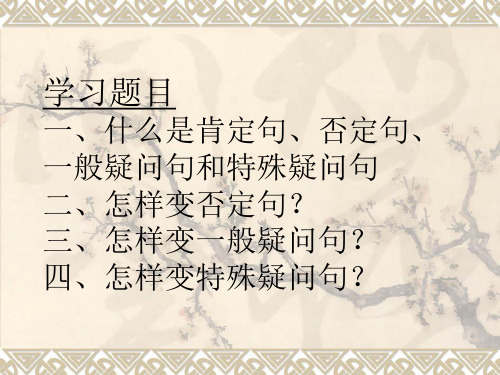
二、怎样变否定句
有am,
is, are的句子, 肯定句变否定句:在am, is, are后面加上not,其 余按顺序照抄。 例如:I am a boy. I am not a boy. He is a teacher. He is not a teacher. They are friends. They are not friends. 他们是朋友。 他们不是朋友。
学习题目
一、什么是肯定句、否定句、 一般疑问句和特殊疑问句 二、怎样变否定句? 三、怎样变一般疑问句? 四、怎样变特殊疑问句?
一、be动词:am,
is, are 二、肯定句、否定句、一般疑问句和特殊 疑问句定义 1.肯定句:表示肯定的意思, 即不含有否 定词“不”。 比如:我是一个学生 I am a student. 他是一个老师。He is a teacher. 2.否定句:表示否定的意思。 比如:我不是一个男孩。 I am not a boy 他不是一个老师。 He is not a teacher.
一般疑问句:回答为“是yes”或者“否no” 的问句。 比如:你是一个学生吗? Are you a student? Yes, I am./No, I am not. 4. 特殊疑问句:回答不是“是yes”或者“否 no”的问句,而是根据提问内容具体回答。 比如:这是什么? What’s this? It is a map.
四、怎样变特殊疑问句?
就划线部分提问(变特殊疑问句)
This
is a book. 第一步:变一般疑问句 Is this a book? 第二步:找合适的特殊疑问词 Is this what ? 第三步:特殊疑问词提前放到句首,并大写, 其余按顺序照抄,省略划线部分。得出正确 答案:What is this?
(知识点)肯定句否定句和一般疑问句的转换

(知识点)肯定句否定句和一般疑问句的转换肯定句、否定句和一般疑问句是英语语法中的基本概念,它们在日常交流以及英语学习中起着重要的作用。
本文将详细探讨这三种句子结构的转换方法,并且给出一些实例以帮助读者更好地理解和运用。
一、肯定句的转换在转换肯定句时,我们一般使用否定词"not"来实现。
将肯定句转换为否定句的方法可以分为两种情况:1. 当肯定句中没有助动词时,我们在句子中加入助动词"do",并在"do"后面加上否定词"not"。
例如:肯定句:She speaks English.否定句:She does not speak English.2. 当肯定句中已经包含助动词时,我们直接在助动词后面加上否定词"not"即可。
例如:肯定句:He can swim.否定句:He cannot swim.需要注意的是,在口语中,人们常常使用缩略形式来表示否定形式。
例如,"does not"缩写为"doesn't","cannot"缩写为"can't"。
二、否定句的转换与肯定句相反,我们要将否定句转换为肯定句时,需要去掉否定词"not"。
1. 当否定句中含有助动词时,我们直接去掉否定词"not"即可。
例如:否定句:I am not interested in sports.肯定句:I am interested in sports.2. 当否定句中没有助动词时,我们需要添加助动词"do",并将助动词变为肯定形式。
例如:否定句:They don't like spicy food.肯定句:They do like spicy food.需要注意的是,一些动词本身已经具有否定意义,如"nobody"(没有人)、"nothing"(没有什么)等。
(完整word版)英语肯定句改为否定句、陈述句改为一般疑问句的方法和技巧
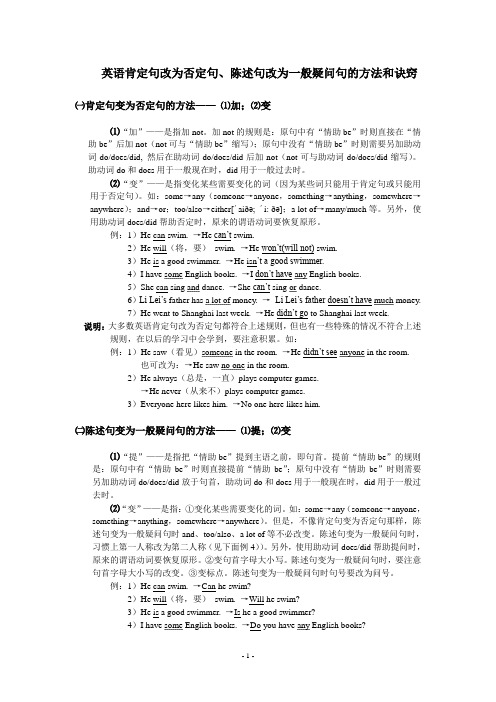
英语肯定句改为否定句、陈述句改为一般疑问句的方法和诀窍㈠肯定句变为否定句的方法——⑴加;⑵变⑴“加”——是指加not。
加not的规则是:原句中有“情助be”时则直接在“情助be”后加not(not可与“情助be”缩写);原句中没有“情助be”时则需要另加助动词do/does/did, 然后在助动词do/does/did后加not(not可与助动词do/does/did缩写)。
助动词do和does用于一般现在时,did用于一般过去时。
⑵“变”——是指变化某些需要变化的词(因为某些词只能用于肯定句或只能用用于否定句)。
如:some→any(someone→anyone,something→anything,somewhere→anywhere);and→or;too/also→either[´aiðə; ´i: ðə];a lot of→many/much等。
另外,使用助动词does/did帮助否定时,原来的谓语动词要恢复原形。
例:1)He can swim. →He can’t swim.2)He will(将,要)swim. →He won’t(will not) swim.3)He is a good swimmer. →He isn’t a good swimmer.4)I have some English books. →I don’t have any English books.5)She can sing and dance. →She can’t sing or dance.6)Li Lei’s father has a lot of money. →Li Lei’s father doesn’t have much money.7)He went to Shanghai last week. →He didn’t go to Shanghai last week.说明:大多数英语肯定句改为否定句都符合上述规则,但也有一些特殊的情况不符合上述规则,在以后的学习中会学到,要注意积累。
疑问句和否定句的转换技巧

疑问句和否定句的转换技巧疑问句和否定句是英语语法中常用的句型,它们在表达和交流中扮演着重要的角色。
熟练掌握疑问句和否定句的转换技巧对于英语学习者来说是非常重要的。
本文将探讨疑问句和否定句的转换技巧,并提供一些实用的例子来帮助读者更好地理解和运用。
一、疑问句的转换技巧1. 肯定疑问句转否定句肯定疑问句是一种既包含肯定含义又用疑问句形式表达的句型。
将肯定疑问句转换为否定句的技巧是改变谓语动词的形式或添加否定词。
例如:- Are you going to the party?(你要去参加派对吗?)- No, I am not going to the party.(不,我不去参加派对。
)2. 反意疑问句转否定句反意疑问句是一种在陈述句后面附加一个简短的疑问部分的句型。
将反意疑问句转换为否定句的技巧是将前文的肯定转换为否定。
例如:- You like coffee, don't you?(你喜欢咖啡,对吗?)- No, I don't like coffee.(不,我不喜欢咖啡。
)3. 特殊疑问句转否定句特殊疑问句是一种以特殊疑问词(如what, where, when, why等)开头的疑问句。
将特殊疑问句转换为否定句的技巧是在否定词前添加适当的特殊疑问词。
例如:- When does the train arrive?(火车什么时候到?)- I don't know when the train arrives.(我不知道火车什么时候到。
)二、否定句的转换技巧1. 标准否定句转疑问句标准否定句是以否定词(如not, never, neither等)开头的句子。
将标准否定句转换为疑问句的技巧是将主语和谓语动词倒置。
例如:- He does not like ice cream.(他不喜欢冰淇淋。
)- Does he not like ice cream?(他不喜欢冰淇淋吗?)2. 否定词的前移否定词可以通过移动位置改变句子的含义和结构。
陈述句肯定句变否定肯定句变一般疑问句及特殊疑问句.

一、陈述句:用于陈述事实和观点。
包括肯定结构和否定结构,句末用句号。
二、肯定句→否定句:1.主语+系动词be + 表语。
在be(am\is\are\was\were)后加not;如:The dog is playing in the room. → The dog is not playing in the room.2. 主语 + 情态动词 + 动词原形 + 其他。
在情态动词(can ,should,must ,would)后面加not;如:He can dance.→He can not dance.3.主语+实义动词+其他。
要借助助动词do , does, did;①句中动词为原形的,加don’t .如:I like apples. →I don’t like apples.②句中动词为三单式的,加doesn’t,并将三单式的动词还原成原形。
如:He likes apples.→ He doesn’t like apples.③时态为过去时的,要加didn’t 而且动词过去式要改为原形,如:I went to school yesterday .→I didn’t go t o school yesterday .注:肯定句中的some、something、somebody等在否定句中分别改成any、anything、anybody等,already要改成yet,too改成either, both改成neither, all 改成none等。
如:There are some students in the classroom.→There are not any students in the classroom.三、肯定句→一般疑问句——三步法●一般疑问句:只能用yes(是)或no(否)来回答的疑问句。
一般结构:系动词be/情态动词/助动词+主语+其他成分通常回答:肯定:Yes,主语+提问的系动词be/助动词/情态动词.否定:No,主语+提问的系动词be/助动词/情态动词的否定形式. 如:① Is she from America? 她来自美国吗?-Yes, she is. / No, she isn't. 是的,她是。
小学英语所有句型转换的方法

小学英语所有句型转换的方法1.肯定句转否定句:在句子前面加上"不"或"没有"。
例子:I can swim.(我会游泳。
)→ I can't swim.(我不会游泳。
)2.否定句转肯定句:在句子前面去掉"不"或"没有"。
例子:She doesn't like ice cream.(她不喜欢冰淇淋。
)→ She likes ice cream.(她喜欢冰淇淋。
)3.一般疑问句转肯定句:将助动词提到句子的主语前。
例子:You like chocolate.(你喜欢巧克力。
)→ Do you like chocolate?(你喜欢巧克力吗?)4.肯定句转一般疑问句:将助动词提到句子的主语前并在句尾加上问号。
例子:He can swim.(他会游泳。
)→ Can he swim?(他会游泳吗?)5.一般疑问句转否定句:在句子前面加上"不"或"没有"。
例子:Does she like ice cream?(她喜欢冰淇淋吗?)→ Doesn't she like ice cream?(她不喜欢冰淇淋吗?)6.否定句转一般疑问句:将助动词提到句子的主语前并在句尾加上问号。
例子:He doesn't play basketball.(他不打篮球。
)→ Doesn't he play basketball?(他不打篮球吗?)7.肯定句转选择疑问句:在句子后面加上疑问词和两个选项。
例子:They like pizza.(他们喜欢比萨饼。
)→ Do they like pizza or hamburgers?(他们喜欢比萨饼还是汉堡包?)8.选择疑问句转肯定句:根据选项的情况作肯定回答。
例子:Do you like apples or oranges?(你喜欢苹果还是橙子?)→ I like appl es.(我喜欢苹果。
肯定句否定句和一般疑问句的转换方法解析
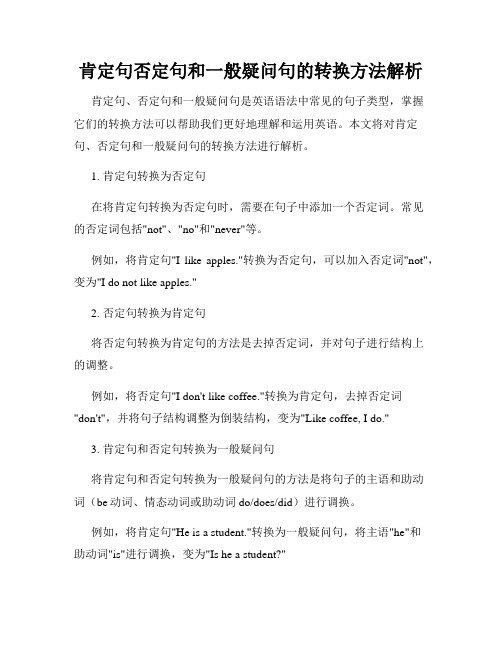
肯定句否定句和一般疑问句的转换方法解析肯定句、否定句和一般疑问句是英语语法中常见的句子类型,掌握它们的转换方法可以帮助我们更好地理解和运用英语。
本文将对肯定句、否定句和一般疑问句的转换方法进行解析。
1. 肯定句转换为否定句在将肯定句转换为否定句时,需要在句子中添加一个否定词。
常见的否定词包括"not"、"no"和"never"等。
例如,将肯定句"I like apples."转换为否定句,可以加入否定词"not",变为"I do not like apples."2. 否定句转换为肯定句将否定句转换为肯定句的方法是去掉否定词,并对句子进行结构上的调整。
例如,将否定句"I don't like coffee."转换为肯定句,去掉否定词"don't",并将句子结构调整为倒装结构,变为"Like coffee, I do."3. 肯定句和否定句转换为一般疑问句将肯定句和否定句转换为一般疑问句的方法是将句子的主语和助动词(be动词、情态动词或助动词do/does/did)进行调换。
例如,将肯定句"He is a student."转换为一般疑问句,将主语"he"和助动词"is"进行调换,变为"Is he a student?"同样地,将否定句"I don't like dogs."转换为一般疑问句,将主语"I"和助动词"don't"进行调换,变为"Do you like dogs?"4. 一般疑问句转换为肯定句和否定句将一般疑问句转换为肯定句和否定句的方法是根据问句的答案进行回答。
英语转换句型的方法和技巧

英语转换句型的方法和技巧1. 肯定句与否定句的转换:在英语中,肯定句和否定句之间的转换通常通过在动词前添加或删除“not”来实现。
例如,将“She is a doctor”转换为否定句,可以说“She is not a doctor”。
2. 陈述句与疑问句的转换:将陈述句转换为疑问句可以使用疑问词(如 what, where, when, why, how 等)来引导。
例如,将“He goes to school by bus”转换为疑问句,可以说“How does he go to school?”。
3. 主动语态与被动语态的转换:主动语态表示主语执行动作,而被动语态则将动作的执行者放在句子的后面,使用“be 动词+过去分词”的形式。
例如,将“She writes a letter”转换为被动语态,可以说“A letter is written by her”。
4. 简单句与复合句的转换:复合句由两个或更多的简单句通过连词(如 and, but, or, because 等)连接而成。
例如,将“She is a doctor. She works in a hospital”转换为复合句,可以说“She is a doctor who works in a hospital”。
5. 句子类型的转换:可以将句子转换为不同的类型,如感叹句、祈使句、疑问句等。
例如,将“She is a beautiful girl”转换为感叹句,可以说“What a beautiful girl she is!”6. 直接引语与间接引语的转换:直接引语是直接引用别人的话,而间接引语则是转述别人的话。
在转换时,需要注意人称、时态、时间状语等的变化。
例如,将“He said, ‘I like apples’”转换为间接引语,可以说“He said that he liked apples”。
这些是一些常见的英语句型转换方法和技巧。
否定句_一般疑问句和特殊疑问句讲解
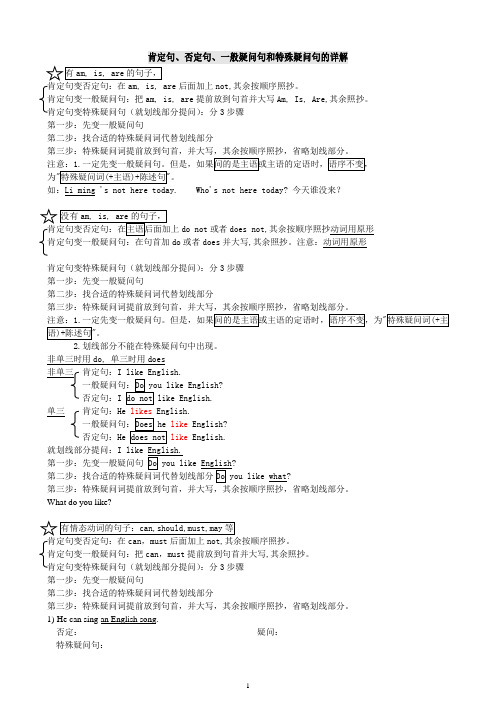
肯定句、否定句、一般疑问句和特殊疑问句的详解有 am, is, are 的句子, 肯定句变否定句:在 am, is, are 后面加上 not,其余按顺序照抄。
肯定句变一般疑问句:把 am, is, are 提前放到句首并大写 Am, Is, Are,其余照抄。
肯定句变特殊疑问句(就划线部分提问) :分 3 步骤 第一步:先变一般疑问句 第二步:找合适的特殊疑问词代替划线部分 第三步:特殊疑问词提前放到句首,并大写,其余按顺序照抄,省略划线部分。
注意:1.一定先变一般疑问句。
但是,如果问的是主语或主语的定语时,语序不变, 为" 特殊疑问词(+主语)+陈述句 "。
如:Li ming 's not here today. Who's not here today? 今天谁没来? 没有 am, is, are 的句子, 肯定句变否定句:在主语后面加上 do not 或者 does not,其余按顺序照抄动词用原形 肯定句变一般疑问句:在句首加 do 或者 does 并大写,其余照抄。
注意:动词用原形 肯定句变特殊疑问句(就划线部分提问) :分 3 步骤 第一步:先变一般疑问句 第二步:找合适的特殊疑问词代替划线部分 第三步:特殊疑问词提前放到句首,并大写,其余按顺序照抄,省略划线部分。
注意:1.一定先变一般疑问句。
但是,如果问的是主语或主语的定语时,语序不变,为" 特殊疑问词(+主 语)+陈述句 "。
2.划线部分不能在特殊疑问句中出现。
非单三时用 do, 单三时用 does 非单三 肯定句:I like English. 一般疑问句: Do you like English? 否定句:I do not like English. 单三 肯定句:He likes English. 一般疑问句: Does he like English? 否定句:He does not like English. 就划线部分提问:I like English. 第一步:先变一般疑问句 Do you like English? 第二步:找合适的特殊疑问词代替划线部分 Do you like what? 第三步:特殊疑问词提前放到句首,并大写,其余按顺序照抄,省略划线部分。
英语所有句型转换的方法(陈述句变否定句,一般疑问句特殊疑问句及练习)

英语所有句型转换的方法(陈述句变否定句,一般疑问句特殊疑问句及练习)英语所有句型转换的方法基本助动词只有三个:be, do, have, 他们没有词汇意义,只有语法作用,如协助构成进行体,完成体,被动态,否定句,疑问句等。
一、肯定句改否定句的方法——一步法1、在be动词后加not。
如:is not ,are not ,am not,was not,were not;2、在can,等后加not。
如:cannot3、上述都没有的,在动词前加助动词否定形式do not, does not. (don’t/doesn’t)4、some 改成any。
二、肯定句改一般疑问句的方法——三步法1、把be动词放在句首,剩下的照抄,(some 改成any,my改成your等)句点改成问号。
2、把can,等放到句首,剩下的照抄,(some 改成any,my改成your等)句点改成问号。
例如:陈述句: They are in the park. He can play the guitar.. 一般疑问句: Are they in the park? Can he play the guitar?把下列句子变成一般疑问句1. I am listening to music._______________________________________2. Mike is a student._______________________________________3. Sarah can clean the classroom.________________________________________4. They are in the zoo.________________________________________5. There are some flowers in the vase.________________________________________6.This is my sister._________________________________________7.We are sweeping the floor.__________________________________________3、上述都没有的,在句首请助动词Do/Does帮忙,剩下的照抄,(some 改成any,my改成your等)句点改成问号。
句型转换规则总结

句型转换规则总结一、肯定句变一般疑问句:分为两种情况,情况一:句中含有Be动词或有情态动词,此时,变化规则为:1.一提:把Be动词或情态动词直接提到句首;2.二改:句中有第一人称的要改为第二人称,同时,提前的Be动词或情态动词改为大写;3.三加:句尾加问号。
情况二:句中不含有Be动词或有情态动词,即实义动词作谓语,此时变化规则为:1.一加:在句首加上do 的适当形式;2.二改:句中有第一人称的要改为第二人称,句首要大写;3.三加:句尾用问号。
二、肯定句变否定句:1.先看句中有没有Be动词或有情态动词,有的话,在其后直接加not,没有,则在句子的主语后,加上do的适当形式,再加not;2.句中如果有some 要改为any;3.如果句子主语为第三人称单数,当加入do 以后,由do来体现人称变化,原句的动词要还原为动词原形。
三、单数句变复数句:相当的各个词都变为复数形式,其中,物主代词与定冠词the 不必变化。
this—these that---those I---we he/she/it ----theya/an---some/any 也可直接去掉is /am ----are名词要变为复数形式四、画线部分提问:1.找:找准合适的疑问词。
What 对物体提问,译成“什么”When 对时间提问,译成“何时”“什么时候”Where对地点提问,译成“哪里”Who 对人提问,译成“谁”How old 对年龄提问,译成“几岁”What time 对具体几点提问,译成“几点”What color对颜色提问,译成“什么颜色”How对方式方法或身体状态提问,译成“怎么样”How much 有两种,一是对价格提问,译成“多少钱”二是对不可数名词的数量提问,译成“多少”How many 对可数名词的量提问,译成“多少”,后面必须加可数名词的复数2.变:把原句去掉划线部分,其余部分变成一般疑问句,如果划线部分是动词,要用do的相应形式替换后再变一般疑问句;3.加:句尾加问号。
句子变换的方法与技巧

句子变换的方法与技巧(一)陈述句与把字句、被字句的变换陈述句与“被”、“把”字句所表达的意思基本相同,但句式变了,使用的场合和效果也有差别。
例如:一大滴松脂整个儿包住了苍蝇和蜘蛛。
(陈述句)一大滴松脂把苍蝇和蜘蛛整个儿包住了。
(把字句)苍蝇和蜘蛛被一大滴松脂整个儿包住了。
(被字句)由上例可知,把字句的主语是动作的执行者,被动句的主语是动作的被执行者。
变换的详尽方法是:找出陈述句中的两个称谓,(谁或什么)并确定它们之间的执行者与被执行者关系。
2、把字句:要强调执行者,就将句中执行者(例:一大滴松脂)调到句首做主语,后面再加上“把”字和被执行者,即成把字句。
3、被字句:要强调被执行者,就将句中的被执行者(例:苍蝇和蜘蛛)调到句首做主语,后面再加上“被”字和执行者,即成被字句。
(二)肯定句与否定句的变换把肯定句改为否定句非常简单,直接在表示肯定的词语前加否定词即可。
如果说肯定句是数学中的正数,否定句是负数,那么双重否定句就是“负负相乘得正”,双重否定句不仅可以表达肯定的意思,而且,其肯定的语气较原来更加强①”、“非不”、“不能不”等。
例如:许多国外的科学家都惊叹秦俑无与伦比的高超艺术。
(肯定句)许多国外的科学家都不得不惊叹秦俑无与伦比的高超艺术。
(双重否定句)。
(三)陈述句与反问句的变换陈述句就是把要表达的思想内容平铺直叙的表达出来,不带有任何感情色彩。
而反问句则是通过反问的语气,把原来陈述的意思进一步强调。
虽然反问句是用疑问句的形式表达出来,但其句子本身就包含着答案,是不需要回答的。
反问句的感情色彩比较剧烈,朗读时语调较高。
例①”面对任何灾难,中华民族不会望而却步。
(陈述句)面对任何灾难,中华民族会望而却步吗?(反问句)面对任何灾难,中华民族难道会望而却步吗?(反问句)②班长坐在那里捧着搪瓷碗,嚼着几根草根和我们吃剩的鱼骨头,我觉得好象有万根钢针扎着喉管。
(陈述句)看着老班长坐在那里捧着搪瓷碗,嚼着几根草根和我们吃剩的鱼骨头,我怎能不觉得好象有万根钢针扎着喉管呢?(反问句)。
英语句型转换常规基本句式的转换方法

英语句型转换常规基本句式的转换方法英语句型转换常规基本句式的转换方法、技巧点拨“句型转换”有两种形式,一是按要求转换句型(如:要求将陈述句转换为否定句或一般疑问句;改为祈使句或感叹句;对划线部分提问等);二是“同义句转换”。
本题型在中考中重要是测试我们运用英语“句型”的能力。
“四位一体”的“句型转换”专项训练,就是为了发展我们这方面的能力。
第一类题型的转换,重点是基本句型的运用,一般都有规律可循。
除了熟记基本句式的结构外,还要注意some, any; already, yet 等词在转换时的变化。
第二类句型转换(同义句转换)应该作为我们复习训练的重点。
用不同的句式表达相同的意思,它标志着一个人的外语能力水平。
提高此项能力的关键是熟悉句型结构,自如运用。
通过“专项训练”,积累一定数量的相关句式,达到脱口而出,信手拈来,出神入化。
基本句式的转换主要是指“肯定句、否定句、一般疑问句、特殊疑问句、反意疑问句和选择疑问句、祈使句、感叹句”的相互转换。
句式的转换一般都有一定的规律可循,我们就是要掌握它们的变化规律,能够举一反三,见此知彼。
(一)肯定句、否定句、一般疑问句的相互转换这三种句型的转换有共同的规律可循,有几个要点必须牢记。
我们可以把各种句式归为两大类:1、含有的be动词、助动词和情态动词的句子;2、只有行为动词的句子。
第1类的句子,肯定句改为否定句时,一律在be动词、助动词和情态动词后加“not”,改为一般疑问句时,一律将be动词、助动词和情态动前移到句首(首字母大写)。
肯定回答用“Yes”;否定回答用“No”。
“Yes”或“No”后面的主语必须用代词,“No”后面必须用否定缩略式。
如:将下列句子改为否定句、一般疑问句,并做肯定、否定回答:1. There are some computers in this school. (be动词)There aren’t any computers in this school.Are there any computers in this school? (Yes, there are. / No, there aren't.) 2. Li Ming’s father can drive the car. (情态动词) Li Ming’s father can’t drive the car.Can Li Ming’s father drive the car? (Yes, he can. / No, he can’t.)3. She has already finished his homework now. (助动词)She hasn’t finished his homework yet.Has she finished his homework yet? (Yes, she has. / No, she hasn’t.)第2类句子必须借助助动词do; does; did。
- 1、下载文档前请自行甄别文档内容的完整性,平台不提供额外的编辑、内容补充、找答案等附加服务。
- 2、"仅部分预览"的文档,不可在线预览部分如存在完整性等问题,可反馈申请退款(可完整预览的文档不适用该条件!)。
- 3、如文档侵犯您的权益,请联系客服反馈,我们会尽快为您处理(人工客服工作时间:9:00-18:30)。
肯定句/否定句/疑问句之变形技巧一、肯定句改否定句1、be动词后加not,诸如:is not(isn't),are not(aren't),was not(wasn't),were not(weren't),am not(无缩写)。
◆He is a student. 他是一个学生。
--- He is not a student. 他不是一个学生。
◆They were watching TV then. 那时他们正在看电视。
--- They weren't watching TV then. 那时他们没在看电视。
2、情态动词等后加not,诸如:can not(can't),will not(won't),should not(shouldn't),must not(mustn't),need(needn't)等。
◆She can take care of herself. 她能照顾好她自己。
--- She can not(can't) take care of herself. 她不能照顾好她自己。
◆You should go home. 你应该回家。
--- You shouldn't go home. 你不应该回家。
3、若无法找到be动词或情态动词,就在已有动词前额外加助动词否定形式:don't/doesn't/didn't,同时将动词变原形。
◆She likes the room. 她喜欢这房间。
--- She doesn't like the room. 她不喜欢这房间。
◆We did our homework yesterday. 我们昨天做了作业。
--- We didn't do our homework yesterday. 我们昨天没有做作业。
注:句中若有some ,须将其改成any。
◆I want some books. 我想要一些书。
--- I don't want any books. 我不想要任何书。
◆There is some water in the cup. 杯子里有一些水。
--- There isn't any water in the cup. 杯子里没有水了。
二、肯定句改一般疑问句(三步法)#1:把be动词(am/is/are...)或情态动词(can/will...)放在句首。
若句中没有上述动词,就把助动词放在句首(do/does/did),同时将动词变原形。
#2:剩余部分照写。
注:some须改成any,I或we均改成you,my或our均改成your。
#3:句点改成问号。
◆I can swim. 我会游泳。
Can you swim? 你会游泳吗?◆There is some water in the cup. 杯子里有一些水。
Is there any water in the cup. 杯子里有水吗?◆I studied hard. 我学习认真。
Did you study hard? 你学习认真吗?三、肯定句改特殊疑问句(四步法)#1:在一般疑问句基础上,句首添加一个疑问词即可,但应根据划线部分选用适配的疑问词。
#2:把be动词或情态动词等放在疑问词后面,若句中没有上述动词,就用助动词替代(do/does/did)。
注:Whose(谁的)和How many(多少)两词除外,须紧跟物品,再写be动词或情态动词等。
#3:划线部分去掉后剩下的内容照写。
注:some须改成any,I或we均改成you,my或our均改成your。
#4:句点改成问号。
★考试中出现频率颇高的20个特殊疑问句1、划线部分是“事或物”,疑问词用What。
◆This is a book. 这是一本书。
--- What is this? 这是什么?◆I often play football on Saturdays. 我经常在周六踢足球。
--- What do you often do on Saturdays? 你经常在周六做什么?2、划线部分是“职业”,疑问词用What。
◆Mike is a worker. 迈克是一个工人。
--- What is Mike? 迈克是做什么的?◆I'm a policeman. 我是一名警察。
--- What do you do? 你是做什么的?3、划线部分为“人名”,疑问词用What。
My name is Amy. 我叫艾米。
--- What's your name? 你叫什么名字?4、划线部分为“天气”,疑问词用What或How。
It's cold and windy in winter. 冬天很冷,而且风大。
--- What's the weather like in winter? 冬天的天气怎么样?(= How is the weather in winter in Beijing?)5、划线部分是“颜色”,疑问词用What colour。
My hat is blue. 我的帽子是蓝色的。
--- What colour is your hat?你的帽子是什么颜色?6、划线部分是“星期几”,疑问词用What day。
It's Monday. 今天星期一。
--- What day is today? 今天星期几?7、划线部分是“时间”,疑问词用What time或When。
◆It's seven twenty. 现在七点二十。
--- What time is it? 现在几点了?◆I usually get up at six. 我通常六点起床。
--- When do you usually get up? 你通常什么时候起床?8、划线部分是“人”,疑问词用Who。
He is my brother. 他是我哥哥。
--- Who is he? 他是谁?9、划线部分是“形容词性物主代词或名词性物主代词”,疑问词用Whose。
This is my bag.(= This bag is mine.)这是我的包。
--- Whose bag is this? 这是谁的包?10、划线部分是“原因”,疑问词用Why。
He isn't at school because he is ill. 他因为生病而没去学校。
--- Why isn't he at school? 他为什么不在学校?11、划线部分是“地点”,疑问词用Where。
The box is on the desk. 这盒子在桌上。
--- Where is the box? 盒子在哪里?12、划线部分是“方式”,疑问词用How。
She usually goes to school by bike. 她通常骑自行车去上学。
--- How does she go to school? 她是怎样去上学的?13、划线部分是“年龄”,疑问词用How old。
I'm twelve. 我十二岁。
--- How old are you? 你多大了?14、划线部分是“数量”,疑问词用How many或How much。
◆I can see five kites. 我能看到五只风筝。
--- How many kites can you see? 你能看见几只风筝?◆There is some milk in the glass. 杯里有一些牛奶。
--- How much milk is there in the glass? 杯里有多少牛奶?15、划线部分是“多少钱”,疑问词用How much。
This pen is nine yuan. 这笔价格九元。
--- How much is this pen? 这笔多少钱?16、划线部分是“距离”,疑问词用How far。
It's ten minutes' walk. 步行十分钟的路程。
--- How far is it? 到那有多远?17、划线部分是“长度”,疑问句用How long。
The river is about 500 km. 这条河长约500千米。
--- How long is the river? 这条河有多长?18、划线部分是“频率”,疑问词用How often。
I watch TV twice a week. 我一星期看两次电视。
--- How often do you watch TV? 你每多久看一次电视?19、划线部分是“时长”,疑问词用How long或How soon。
◆I will stay there two weeks. 我将会在那儿呆两个星期。
--- How long will you stay there? 你将在那儿呆多久?◆He will come back in an hour. 他一小时后回来。
--- How soon will he come back? 他过多久回来?20、划线部分是“次数”,疑问词用How many times。
He called me twice yesterday. 他昨天给我打了两次电话。
--- How many times did he call you yesterday? 他昨天给你打了几次电话?。
